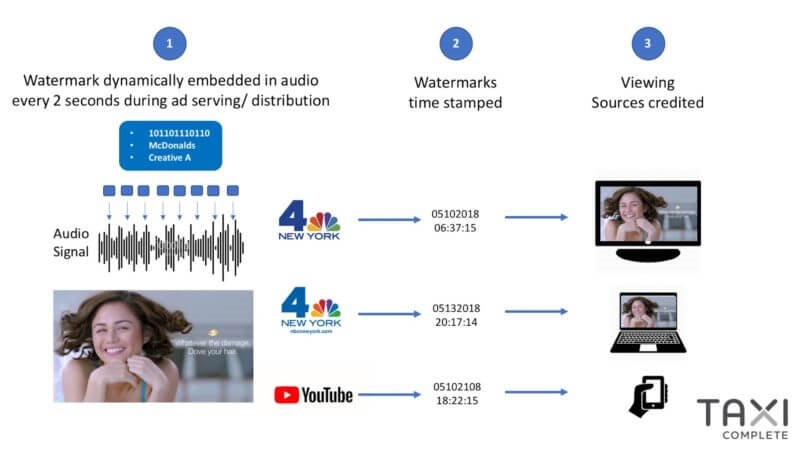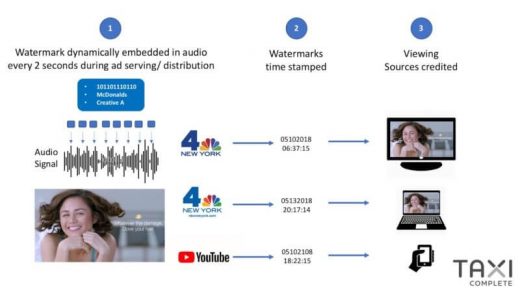SMPTE’s new TAXI Complete could make multiscreen ads and content commonplace
The newly issued standards specify identifiers within the audio track of any video program or ad, whether shown on TV, OTT or online.

CIMM’s visualization of TAXI Complete
SMPTE, the standards body for entertainment technology, has issued two new standards that can support online content and ads synchronized between multiple screens.
Additionally, the new standards could make it much easier for marketers to track where their programs or ads appear, either on TV, over-the-top (OTT) TV, websites, apps or elsewhere.
The new standards, issued earlier this month, are called TAXI Complete (a free white paper is available, but registration is required), and its advocates are touting it as the UPC (Universal Product Code, the ubiquitous bar code on virtually every physical product) for tracking video across platforms.
It takes two existing tracking identifiers — Ad-ID for ads and EIDR (Entertainment Identifier Registry) for program content — and specifies how they can become part of the audio track of any video program or video ad. One standard identifies the ad or program, and one identifies where the ad or program is shown.
Previously, Ad-ID and EIDR had been utilized by producers and agencies to tag their programs or ads, but only as part of a separate registry. For instance, episode 3 of NBC’s “This Is Us” TV series might have an EIDR ID of, say, 123, but that would be stored in a separate database, not within the program.
SMPTE put out a call for technology to embed these two identifiers inside of the program or ad itself and recently announced it had selected the audio watermarking technology from Kantar Media.
Repeated every few seconds
The unique identifiers can now be embedded into the audible audio track of each program and ad, so they can be read by presenting systems, such as a cable system’s set-top box. The acoustical identifying signal can’t be heard by viewers, but it can be deciphered from the audio track by a viewer’s mobile app if that app utilizes a supporting software development kit (SDK).
Jane Clarke, CEO of TV/video industry organization CIMM (The Coalition for Innovative Media Measurement), told me that the identifiers include the program or ad title and a code for where it was displayed. So, if that episode 3 of “This Is Us” was shown via Amazon Prime Video, the identifiers will reflect that. Her organization has been involved in the development of TAXI Complete.
The identifier is repeated every few seconds on the audio track, with an updated time stamp. This means that a viewer with a supporting app on her smartphone could see ads or content that are synchronized, within a few seconds, to the exact scene shown on a TV, computer or that same smartphone, via this triggering identifier. Multiple screen interactions have been attempted over the years, but they always required some kind of custom coordinating signal that limited their applicability.
Additionally, these identifiers can provide a standardized method for tracking video ad exposure across screens, measuring attribution, maintaining brand safety by providing data on the context where ads are shown, and supporting the more complete integration of the sprawling TV ecosystem into digital ad targeting.
The closest competing system, Clarke said, is an audio watermarking system that audience measurement firm Nielsen has used for years. But that proprietary system identifies only a program’s channel and time. A match then needs to be made with the published schedule to find out the program name. Additionally, it doesn’t identify the ads but infers the average number of ad minutes per show.
Clarke noted that, since the standards have just come out, vendors are now looking into the development of supporting set-top boxes, SDKs or other components to make these identifiers a universal way of tracking video content and video ads.
Marketing Land – Internet Marketing News, Strategies & Tips
(21)



